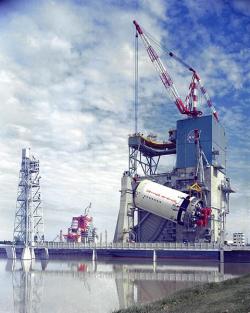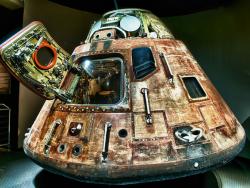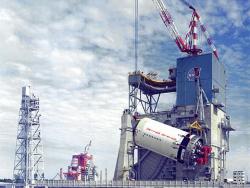The largest rocket built at the time of the historic first missions to the moon, the Saturn V carried aloft the 45-ton Apollo spacecraft on earth orbital and lunar missions from 1967 to 1972. It also launched the 120-ton Skylab into earth orbit on May 14, 1973.
Saturn V

YearAdded:
Image Credit:
Public Domain (NASA)
Image Caption:
The largest rocket engines built at the time of the first US missions to the moon.
Era_date_from:
1967
1980

The Advanced Engine Test Facility was built in 1964, three years after President John F. Kennedy committed the United States to world leadership in aeronautical science. Conceived and designed by Wernher von Braun, the first director of the Marshall Space Flight Center, this facility was used to perform static tests on the booster of the Saturn V rocket, which launched Apollo 11 to the moon on July 16, 1969.
The stand has four concrete legs, each four feet thick and rising 144 feet to a steel superstructure supporting a 200-ton crane.
YearAdded:
Image Credit:
Courtesy ASME
Image Caption:
Saturn V Rocket being lifted onto the A-2 Test Stand at NASA's John C. Stennis Space Center
Era_date_from:
1964
1993

6225 Vectorspace Blvd Titusville State: FL Zip: 32780 Country: USA Website: http://www.asme.org/about-asme/history/landmarks/topics-a-l/air-and-space-transportation/-162-apollo-space-command-module-%281968%29, http://nssdc.gsfc.nasa.gov/planetary/lunar/apollo14info.html Creator: North American Aviation
The Apollo was the vehicle that first transported humans to the moon and safely back to earth. Nine lunar flights were made between 1968 and 1972. The command module, built by North American Aviation (at the time of launch, North American Rockwell Corporation), accommodated three astronauts during the mission. It was the only portion of the Apollo spacecraft system designed to withstand the intense heat of atmospheric re-entry at 25,000 mph and complete the mission intact. This command module at Rockwell flew as Apollo 14 in 1971.
YearAdded:
Image Credit:
Courtesy Flickr/Chad Nordstrom (CC BY 2.0)
Image Caption:
The real Apollo Space Command Module on display at the Kennedy Space Center's Saturn V Building.
Era_date_from:
1968
1992

The Apollo was the vehicle that first transported humans to the moon and safely back to earth. Nine lunar flights were made between 1968 and 1972. The command module, built by North American Aviation (at the time of launch, North American Rockwell Corporation), accommodated three astronauts during… Read More

The Advanced Engine Test Facility was built in 1964, three years after President John F. Kennedy committed the United States to world leadership in aeronautical science. Conceived and designed by Wernher von Braun, the first director of the Marshall Space Flight Center, this facility was used to… Read More

The largest rocket built at the time of the historic first missions to the moon, the Saturn V carried aloft the 45-ton Apollo spacecraft on earth orbital and lunar missions from 1967 to 1972. It also launched the 120-ton Skylab into earth orbit on May 14, 1973.
Design and…


